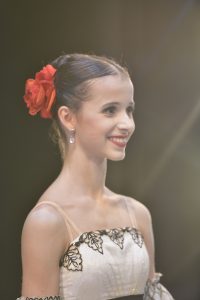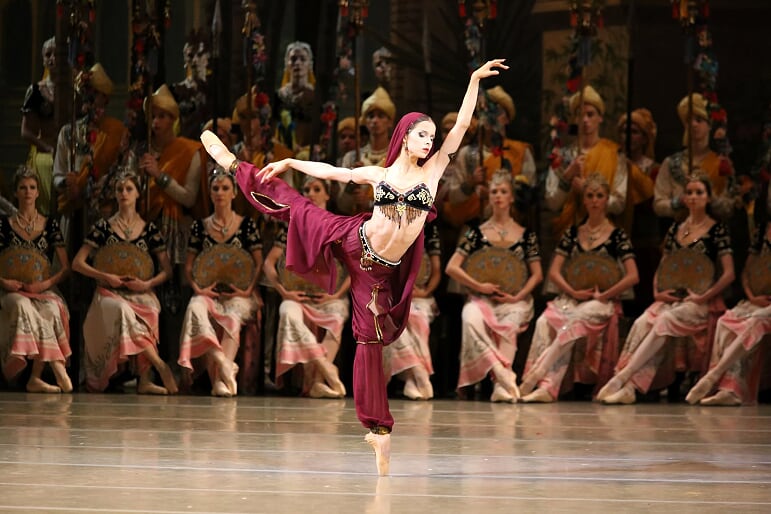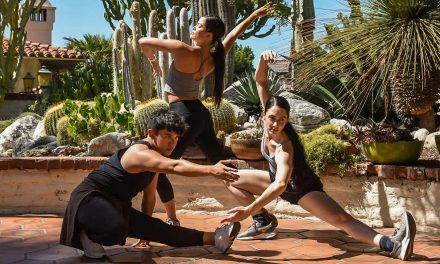I was lucky enough to interview the up and coming ballerina Maria Khoreva currently performing in Southern California with the Mariniisky Ballet at the Segerstrom Center for the Arts in Costa Mesa and at the Music Center Los Angeles. Her answers are just as she gave them with slight adjustments for clarity only. Her passion for her art shines through, as does her amazing grasp of English. Her maturity is impressive and her answers are insightful, charming and even poetic.
What is clear is that the education of a young dancer at the Vaganova School is very thorough and of the highest quality in both dance and academics. Dance history is a major part of that curriculum. Thus her thoughtful answers have a depth of understanding seemingly beyond her years.
Her answer to my question about performing in the United States was particularly provocative especially regarding American critics. Read on, I think you’ll find food for thought.
All in all she is a fascinating new talent, one to watch and with social media we can! You will find links at the end of this article.
Again I would like to thank Maria for taking time out of her very intense schedule to spend with LA Dance Chronicle.
———————————————-
Introduction to Maria Khoreva;
Maria Khoreva, the newest and perhaps brightest star of the Mariinsky Ballet will make her Southern California debut at the Segerstrom Center for the Arts. The 19-year-old Khoreva is considered one of the most important talents to join the Mariinsky Company in recent years. She is often compared to the great Diana Vishneva who like Khoreva graduated from the Vaganova Ballet Academy and studied with legendary teacher, Lyudmila Kovaleva. A social media star as well; Khoreva has over 335 thousand Instagram followers and a contract with Nike.
Khoreva began with rhythmic gymnastics at the age of three and having already placed second in a national competition she auditioned for the Vaganova Ballet Academy at the age of nine and was accepted. Upon graduating she had offers from six major companies including The Bolshoi but felt drawn to join the Mariinisky. In less than one year she was promoted to first soloist, a rare accomplishment. Her repertoire is quite extensive with a concentration of historical works. In particular, the restaging’s of several Marius Petipa ballets along with the mid-century work of George Balanchine.
Maria lives in St. Petersburg with her parents and 15-year old sister, also a student at the Vaganova Academy. Her father works in IT and has helped her with her online presence and her Mother teaches English, which may explain her nearly, perfect command of the language.
It is indeed an honor for LA Dance Chronicle to have this opportunity to interview Maria Khoreva.
Questions;
TW– We know that you are well educated in areas of ballet and academics but I don’t think most of us know how this is accomplished. Please, describe for us a typical day/week at the Vaganova Academy. How are the dance classes organized and how much time is devoted to each class? How do academics fit into the overall schedule? What were your preferred classes in both ballet and academics?
MK-Yes, in fact, I was somehow programmed from the very childhood that there’s only one mark at school – excellent; all the rest are just not marks, they are fails. That’s why I tried to do my best both in ballet and academics.
The typical day in Vaganova starts at 9am with some academics like math, literature, Russian language, history, geography, etc. (45min each) followed by 1,5 hours of classical dance in the middle of the day. Most ballet teachers would use breaks before and after to have more time for ballet practice. (Maybe it’s a secret but I hope you won’t tell anyone.) After ballet class most of the students would get a 45min break and then other dance disciplines follow – character dance, pas de deux, historical dance, acting – each one hour and a half. Normally this will last till 5:30pm. After that rehearsals begin. Usually the working day at the academy ends by 7/7:30pm.
My favorite classes at school were classical dance, of course, to which I would run to try again those things I understood yesterday and check if I can do new ones on its basis. I also loved pas de deux because of the teacher – he was young, handsome and very calm.
As for the academics I loved literature, history of art, and music – mostly ballet related subjects.
TW-You were fortunate enough to have one of, if not the foremost ballet teacher of today, Luydmila Valentinova. She has trained many of the most gifted ballerinas of several generations. What is it that makes her such an extraordinary teacher?
MK-Possession of this hidden knowledge – what makes an extraordinary teacher – would make man a god, because it will launch a mass-production of super-teachers who will produce super-students, sort of supermen. There’s no such recipe or formula, we can only guess. I’m not sure if my guesses are right but what makes Luydmila Valentinovna special is her positivity, good temper and that she’s got no fear of obstacles.
TW-Six companies offered you a position with their company including the Bolshoi, which is extraordinary. What prompted you to chose to join the Mariinsky? Was it the repertoire, or the historical aspect or just the general atmosphere that drew you to them?
MK-The answer is pretty much on the surface. This is my hometown. This is my home theater. And after the first meeting with Yuri Fateev the director of the Mariinsky Ballet, I had no doubt. The first couple of weeks working with him, while I was still a student at Vaganova Ballet Academy, finally convinced me of how much his vision of ballet was in tune with mine.
TW-Speaking of history, at this point many of the ballets you are performing are restaging’s of Marius Petipa’s work. How does this compare to the mid-century work of Balanchine or the contemporary Juliano Nunes work?
MK-They are absolutely consonant. Balanchine – no wonder his style is called neo-classic, that is, a new interpretation of classical works using classical forms, techniques and elements. Nunes, being extremely modern, does not try to get away from ballet, but very logically and with fine taste uses musical and ballet blocks according to his vision, up to classical ones. He, as they say, stands on the shoulders of his predecessors, and does not begin a new branch of dance art, which attracted me a lot. But we do only a short piece of his. With Balanchine, it’s a completely different story, for me it is full-length ballets such as “Jewels”, “Apollo”, “Serenade”, “Midsummer Night’s Dream” that are absolute masterpieces of choreographic art, both for the audience and for the artists. Among all that I happened to dance so far, Balanchine choreography is the most comfortable, natural for my body, the most logical and plastic. I want so much to continue acquaintance with his work. I really do.
TW-When working with a coach such as Elvira Tarasova, who helped you to prepare for the role of Medora in Le Corsaire, what was this interaction like for you? Certainly she would be working with you on the nuances of the choreography but how much emphasis was placed on the building of a character? Acting?

Maria Khoreva in Paquita by Valentin Baranovsky – Photo coutesy of State Academic Mariinsky Theatre.
MK-This is all so non-linear … Of course, Elvira Tarasova provides me invaluable assistance in working on images, revealing and exposing the internal motives of behavior and the logic of certain actions. The same is the case with Yuri Fateev when he rehearses Balanchine. And what also helps is to read heaps of literature, study originals, dig into the history of the creation, investigate the historical era in which the action takes place, costumes, the experience of my predecessors and in general everything that relates to the role to be performed. This is a gigantic amount of information that is sifted through my consciousness, but what remains and begins to work, is up to my subconscious. My task is to give it food and trust in making a decision. There is no place for logic and will. They must be left to class or (smiling) stage appearance a day after arriving to the other end of the world. Imagine, I danced my “Paquita” here in America, the day after I left the plane (St. Petersburg – Moscow – New York – Washington) with a time shift of 8 hours, i.e. in my time the performance began at 2:30 in the morning! And it’s one of the most demanding shows in terms of power and endurance.
TW-Diana Vishneva, who you have been favorably compared to, is an impeccable dancer but moreover brings visceral life to her characters through her acting ability. Is this kind of dramatic ability something your aspire to?
MK-To be honest, acting is what I paid the least attention to while I was a student concentrating on the technical aspects of ballet movements and body expressiveness, roughly speaking, and on pantomime. It seemed to me, and I am still convinced of this, that ballet is about technique and posing, and facial expressions, although bright and accessible, are much more primitive and flat. In other words, a ballerina speaks body language using her legs, arms, neck, head and, of course, the face, but it’s not the main thing. Sometimes it’s even good not to use it as means of expressiveness, as the Japanese do in their kabuki theatre. And sometimes you can’t avoid using it. Now I am seriously working on this. With the divine Diana as well.
TW-What roles are you looking to do in the near future and what roles do you hope to grow into in a few years time?
MK-I am very much looking forward to having two important debuts this winter at the Mariinsky – “Raymonda” in December and “Sleeping Beauty” in February! Both the epitome of classical ballet hence I’m really excited to start working on the style and all the details! Also of course I’m willing to continue improving the roles I’ve already performed – it’s the endless process of refining character and technique. As far as the more distant future – two dream roles come to my mind – Odette/Odille in “Swan Lake” because it’s one of the most legendary ballets and its beauty mesmerizes so many people around the world and Juliet in “Romeo and Juliet” because this love story spreads itself beyond the words and it’s so dear to my heart!!
TW-Who are the contemporary choreographers that you find exciting today?
MK-When I started considering this question I was nearly ready to read out a list of surnames to you, but then … Then I thought that “modern” means literally now, that is, in describes artists creating their choreography today, the ones whose works will appear tomorrow. For example, two years ago I didn’t know Giuliano Nunes, but what apiece he produced for Xander and me! I would like to find exciting choreographers, music, dances and above all – people. I would want to have only exciting people around me.
TW-How does it feel to have such a large Instagram following? Does it add to the pressure of your already full agenda or is it a good way to unwind and relax?
MK-This is passion. Hobby and enjoyment. Social networks – this is one of my realities in which I live. So far, I manage to do only what I really like to do. One of those things is Instagram. I’m thankful that it exists. I thank all my subscribers. I love them all, they are my big family.
TW-What has it been like for you to perform in the United States? Do you feel that you are known in the ballet world including Southern California because of your social media presence?
MK-I love the American public very much. This is an absolutely amazing mixture of my compatriots, wonderful young dancers and sensual connoisseurs of beauty. It seems to me that Americans have an impeccable feeling of rhythm and the finest sense of humor. In general, they are very emotional and sincere.
It’s just criticism that does not spoil them with the depth of their reviews. Very often in articles about ballet you encounter such profound ignorance… That’s why I would like to wish a wonderful and sincere American audience to read not reviews, but at least a few lines from Wikipedia about the history of a ballet and maybe its literary source. This will reveal to you the action unfolding on the stage in a completely different way. You will not just understand ballet, you will get carried away with it.
TW-What does it mean to be an Ambassador for Nike?
MK-Nike is a great team, young, moving, beautiful and athletic. It is very pleasant to work with them. From time to time, we make common projects and the guys taking part in them are very professional and creative. In general, it seems that Nike really appreciates friendly almost family relationships. For example, they attend my performances, and I proudly attend their events. Ambassador of Nike, as I understand it, is a person doing some kind of physical activity and who has achieved certain results in his field and in whose heart the company values resonate, for which high-quality sports shoes and clothing are the key to success, and human relations are the most valued attribute.
TW-I read somewhere you eat a lot to keep your energy at a good level. So, my final question is what is your favorite food?
MK-Cheesecake!!! And all different types of cheese. From Roquefort and Camembert to Parmesan. Funny but I always bring cheese from each country I travel to.
TW- Thank you so much Maria, We all look forward to watching you and your brilliant career.
Check out or in with Maria Khoreva at these sites.
Maria Khoreva (@marachok)
https://www.youtube.com/watch?v=GkYFW_DnbKs (Paquita)
https://www.youtube.com/watch?v=nmofTJvP-KY (La Bayadere)
https://www.youtube.com/watch?v=Ld2uVz5y62I (Tremors)
https://www.youtube.com/watch?v=P9UWBLRzxd4&t=76s (Closure)
“La Bayadere” – Segerstrom Center Oct. 16th through the 20th.
For more information and tickets: “La Bayadere” at the Segerstrom Center for the Arts, click here.
“Jewels” – Music Center Oct. 24th through the 27th, for information and tickets, click here.
Interview by Tam Warner for LA Dance Chronicle, October 18, 2019
Featured image: Maria Khoreva – Photo courtesy of the Mariinsky Ballet












